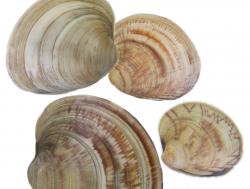Florida Offers Hard Clams Year-Round
January 14, 2011 | 3 min to read

Florida hard clams are harvested year round and are always available in steady supply. Clams are primarily farm raised. Clam farming is one of the newest and fastest growing segments of Florida’s $75 million aquaculture industry.
There are currently 365 certified clam growers working on 1,200 acres of aquaculture leases in Florida. Clam farming ranks first in the state in terms of aquatic food production, with an annual value of $10.7 million in 2005. Most of Florida’s farm-raised clams come from the Cedar Key area in Levy County.
“Clam farming really took off in Florida in the 1990s after the net ban took effect,” said Nelson Mongiovi, Director of Marketing and Development for the Florida Department of Agriculture and Consumer Services. “It helped put unemployed fishing communities back to work.”
Clam farmers lease coastal water bottoms from the state, through the Department’s Division of Aquaculture, which also monitors and manages water for shellfish harvesting. Submerged lands are generally leased in two- to five-acre parcels. Clam farmers plant pea-sized seed clams on the ocean bottom under nets or in mesh bags to protect them from predators (blue crabs, stone crabs, and other animals). In Florida’s warm waters, clams grow quickly. Farmers monitor the clams for 12 to 18 months until they reach market size. During harvest the mesh bags are brought to the surface and the clams are sorted by size. Those too small for harvesting are replanted.
Clams can’t tolerate bacteriological or industrial pollution, so successful clam farming requires excellent water quality. And clam farming itself actually improves water quality — because clams are filter feeders and continually remove algae and nutrients from the water.
“Clam farming is a clean industry, as clam farmers don’t use chemicals, antibiotics, feeds, or other inputs,” Mongiovi said. “Clams are allowed to grow naturally. And as an added benefit, mesh clam bags even act as artificial reefs, providing habitat for billions of marine organisms.”
Clam farming has little negative impact on the environment but plenty of positive impact on local economies. The industry provides hundreds of jobs for residents of coastal communities. Secondary industries, such as the construction of aquaculture nurseries and the manufacture of clamming equipment, spring up in the wake of new clam farms.
The hard clam is a brown, nearly oval-shaped bivalve mollusk with a thick, hard shell that protects the meat. The shell can grow to a width of 4 1/2 inches and is marked by rings or ridges that indicate the clam’s growth and age, which can be more than 30 years. There are two commercially important varieties of hard clams harvested in Florida, the northern quahog (Mercenaria mercenaria) and the southern quahog (Mercenaria campechiensis).
The most prominent features of the hard clam’s body are the foot and the neck, or siphon. The foot allows the clam to bury itself in soft sand or mud. The tube-like neck pumps sea water, up to three gallons an hour, in and out of the clam. During this process the hard clam filters out and feeds on plankton and other microscopic organisms.
When shopping for live clams, make sure the shells are free of cracks. Your nose will tell you if the clams are fresh. Live clams should have a mild sea-breeze aroma.
Clams should never be exposed to sudden temperature change. When storing live clams, do not place them directly on ice or immerse them in water. Store live clams at a constant 41 degrees F in the refrigerator in a container with the lid slightly open. They will remain alive for up to seven days. Drain excess liquid daily. Live clams should close tightly when the shell is tapped. Discard clams that do not close. Shucked clams will keep for up to seven days in the refrigerator.
Before cooking, rinse live clams thoroughly under running water. Clams are thoroughly cooked when their shells open and the meat turns plump and opaque. Lean, firm-textured clams are low in fat, cholesterol, and sodium. They provide calcium and iron and are an excellent source of protein.
Source: Florida Department of Agriculture and Consumer Services/Fresh From Florida
